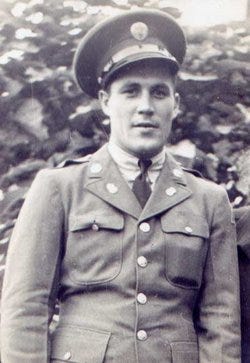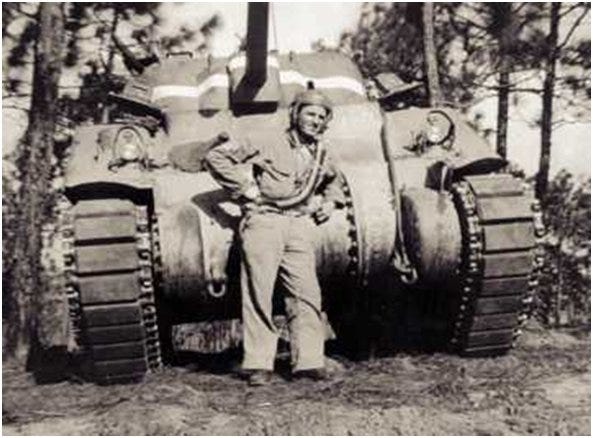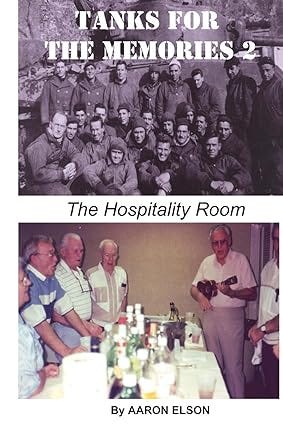Kaye Ackermann, whose father, Rolland Ackermann, was in A Company and who is a better researcher than I, found the Find-a-Grave page for Andrew Lampman and sent me the following note: “Hey, Aaron! I'm just catching up on emails and saw that you had no info on Andrew J. Lampman.” Go to this link for info: PFC Andrew J. Lampman (1925-1945) - Find a Grave...
Pfc. Andrew J. Lampman was a member of B Company of the 712th Tank Battalion attached to the 90th Infantry Division under the command of Gen. George Patton. He was the final Battalion casualty. He had survived combat and was stationed at Camp Randolph in Amberg, Germany for the occupation, but was killed in a truck accident in Schwartzenfeld, Germany four days after the Battalion received orders that it was being sent home.
Also, in my last Substack, I noted that veterans of C Company told me that Bob Henehan was distraught when his brother, who was in the same company, was killed by stepping on a land mine, yet he spoke matter-of-factly of his brother decades later at a reunion, and I wondered about time healing wounds. Then I found the following passage in Louis Gruntz Jr.’s book “A Tank Gunner’s Story” about returning to Europe with his father, in which he quoted B Company veteran Cleo Coleman about Harvey Fowler, who was killed in Doncols, Luxembourg during the Battle of the Bulge:
I seen one boy. What happened, we got replacements. One boy was called to the Army, and his brother volunteered; at that time they let them do this, to stay together. So they came in as replacements while we were in France. Both of them came to our company. One was in the first platoon, and the other was in the third platoon. So the day that one of them would go out and the other didn’t, he stayed behind and worried about his brother. Finally, one day, one of them got it — I think the younger one — and the other one, they sent him back behind the lines. It got to him pretty bad. I never did see him any more.
The death of the five Sullivan brothers when the USS Juneau was sunk brought scrutiny to allowing brothers to serve together but to the best of my knowledge no official policy was put in place.
Everett F. McNulty: One of the brightest and one of the darkest moments in D Company’s history were separated only by seconds. First the brightest, which rated its own page in the unofficial D Company log.
“Another Mark V Bit The Dust,” as told by S/Sgt. Lutcavish
While moving in the lead vehicle of a platoon of light tanks up a road northeast from Alencon, France, the following action took place on the 12th August, 1944:
Upon rounding a curve we suddenly came upon an enemy truck loaded with Germans. Before my gunner, Cpl. O’Farrell, could fire, the truck stopped and backed around the curve. We pursued it and directed fire with the 37 mm. and coaxial guns at a group of dismounted Germans by their truck. About that time I heard a terrific explosion. I looked to the rear and the tank directly behind me was in flames. I caught a glimpse of a whirl of dust caused by a muzzle blast to my right. Immediately I spotted the position under an apple tree at about 125 yards away. I didn’t know for sure what it was or whether it could be knocked out with my 37 mm., but knew I had to do something quick because it was already traversing its gun on to me. There was no cover or no way to go back bacause of the burning tank behind me. Again I heard an explosion and felt my tank lunge forward. A bazooka had hit me in the rear and set the rear end of the tank on fire. What a position for a churchgoing man to be in! There was nothing else to do but to dish it out, so I directed fire on the gun position that looked like that of a tank. That gunner of mine was plenty fast. In less time than it takes to tell he threw 8 well placed rounds of A.P. [armor piercing] into that position and had it on fire. Now we could definitely tell it was a tank, a huge one with a gun that made our 37 look like a pea-shooter. While we were wiping the cold sweat from our brow another enemy tank crossed the road about 400 yards ahead of us. We swung the turret in that direction hoping that we could chalk up another one, but the tank disappeared in the brush before the gunner could fire on it. By this time my tank was burning badly so I ordered the crew to abandon it — disregarding the numbers system, and we made our way back to the rest of the Platoon, toot-sweet, on foot.
And the darkest moment, as described in the unofficial D Company log:
12 August 1944: The 1st platoon moved North through Alencon with the 90th Division Rcn. [recon] Troop, moved through the French 2nd Armored Division, and met enemy resistance at a crossroad South of Les Ragolieres. Sgt. McNulty’s tank was hit by a shot from a German Mark V Tank. Tec. 5 Ezerskis, the driver, was killed and the remaining members of the crew, Sgt. McNulty, Pfc. Jezuit [and Arthur Roselle] were seriously burned and evacuated. [All three died of their burns. When I interviewed Andy Schifler of D Company 30 years ago he got a phone call from platoon mate George Mauzer, and while I never interviewed Mauzer, during a brief conversation on the phone he said McNulty was so badly burned that he begged someone to shoot him.] McNulty had replaced Sergeant Harold Heckler when Heckler was killed accidentally on July 14, and the other three were Heckler’s original crew.]
Jack Mantell: From Find-a-Grave:
Jack left for overseas on January 1, 1945. He landed in England and then went to France where he had sentry duty. On a very cold night, a Frenchman offered him cognac to warm him. He was injured in France, but refused to go to a hospital. He wanted to stay with his group. On March 16th, he was killed in action at Pfaffenheck, Germany. He is missed dearly by his sister, Bella Mantell Fisher.
“Just a night or two before he got hit,” Russell Loop said when I interviewed him in 1993, “we were sitting in a house, and he said, “I’ll make a deal with you.” He had a wife and a little boy. “He said, If I get killed, will you go tell my wife and little boy what happened? Exactly.” And I said, “Well, I’ll make you a deal the same way. Will you go tell my folks?” I did go and tell her. She lived in Milwaukee, Wisconsin. Took me a while go get the nerve up, but I did go tell her, finally.”
The armor-piercing shell went “right straight through the gun shield,” Lieutenant Francis “Snuffy” Fuller said when I interviewed him in 1994, “and that's that thick (four inches), plus the tank body itself (an inch and a half).” Mantell was sitting behind a metal box with .30 caliber ammunition for the coaxial machine gun. “That shell came through the gun mount, through the tank, hit that machine gun box, and drove all these .30-caliber shells right into his chest. I didn't know anything happened to him, but looking around afterward I said, ‘Where's Mantell?’ and this guy says, ‘Don't you know, Lieutenant?’ I said, ‘Know what?’ He says, ‘Look in your tank.’ I walked up and looked, and here he is. It drove those shells — they didn't explode, it just drove them right into his chest.”
After the battle, Mantell’s body remained on the floor of the turret, and the tank’s driver, Carl Grey, was so shaken up that Captain Jack Sheppard, the company commander, had to drive the tank back to the rear with Mantell still inside.
Tullio Micaloni and Nicholas Milczakowski: “That’s where Tullio Micaloni got killed,” Louis Gruntz told his son as they discussed the battleground of Seves Island and the liberation of Perier. “He was in our company, B Company. He went up and his tank got blown up. It was right on the Seves River. These guys should have gotten nothing less than the Silver Star because they didn’t have to die. They were ordered to go and they went. They had to go through that river, the Seves River. The (infantry) colonel gave a direct order for them to take the tank up in there. Captain Galvin (712th B Company commander) didn’t want them to go. Galvin was a big guy, kind of heavyset and boy could he drink some booze. He told Micaloni, ‘Don’t go,’ Micaloni told him, ‘I will go Captain.’ Galvin was right.”
“The terrain was not meant for tank warfare — the surrounding swampy fields could not be traversed by tanks and the northern approaches to the ford had been mined,” Louis Gruntz Jr. wrote in '“A Tank Gunner’s Story.”
“They hit a tank mine and it blew the tank completely up” the elder Gruntz said. All four of the 712th tank crew, Tullio Micaloni, Frank Krusel, Nicholas Milczakowski, and James Gaither were killed, due to the explosive device containing approximately 400 pounds of TNT.
Nicholas Milczakowski, who was from Edwardsville, Pennsylvania, was 23 years old when he was killed. Tullio Micaloni, from Sheppton, Pennsylvania, was 30 when he died. Micaloni has been memorialized as one of “Les Quatre Braves,” a monument in Perier dedicated to the 90th Infantry Division, to which the 712th was attached.
Chancy Miller: Chancy Miller was a 24 year old replacement lieutenant in A Company. He was killed on November 14, 1944 during the attack on Fort Koenigsmacker. According to Dess Tibbetts, a tank driver, Miller was in the lead tank and had parked under a tree, possibly for camouflage, when an artillery shell exploded over the trees and a piece of shrapnel came down and tore through his shoulder. Tibbetts, whom I interviewed in 1995, was holding Miller when he died. “He kept telling me, ‘My arm’s shot off,’” Tibbetts recalled. “He said, ‘My arm's shot off, Tibbitts,’ and I said, ‘No, Lieutenant, your arm isn't shot off.’ I showed him his arm. He said, ‘My arm's shot off.’ And I said, ‘No.’ And he was out of his mind practically, then, I suppose, I thought afterwards. But anyway, after a couple of minutes he just kind of gasped, and he's dead in my arms.”
Lee Miller: When the 712th Tank Battalion retreated across the Saar River in December of 1944, giving up their hard-fought gains to go north and join in the Battle of the Bulge, Lee Miller volunteered to stay behind to sabotage a tank that wouldn’t start. After he did this, he was told, there would be two infantrymen to guide him back across the Saar. When he arrived at the assigned rendezvous, nobody was there, so he swam across the freezing Saar in the middle of December. Jim Cary, the B Company commander, recommended Miller for a Silver Star, which he received. Miller was killed on Feb. 27, 1945 in the town of Krautscheid, Germany.
Duane Miner: The first I heard of Duane Miner’s accidental death was from Reuben Goldstein, who was wounded in the Falaise Gap. Miner was killed a short time later, as the A Company tanks were leaving the Gap and in a non-combat situation. “We had a driver in my platoon,” Ruby said. “Duane Miner. He was from Minneapolis, Minnesota, I think he was. [Duluth, actually] He was married, tall, a handsome looking kid, just married. He was the driver. And in back of the driver, up above, up in the turret, you've got your 75-millimeter, you've got your gunner, tank commander, and your loader, on this side, which is in back of the driver. The gun was so hot from firing, the machine gun, he didn't open up the cover, pull it back, open up the cover. It was so hot. If you've got it on, she's gonna keep firing. And he's sitting up there, he's down below, open up the hatch, he got up, it fired. It was so hot. It killed him. That's how accidents happen.”
I would later hear another account of Miner’s death. I’m going to quote from “Tanks for the Memories 2: The Hospitality Room” by one Aaron Elson:
The third instance of a crew member being killed by friendly fire occurred in A Company as the tanks were emerging from the Falaise Gap. The tanks were not in a combat situation and some of the crew members were protruding from the top of their tanks. Duane Miner was riding on top of the tank when he was struck by a burst from a machine gun accidentally fired from the tank behind his. I learned of this incident early on from Reuben Goldstein, an A Company tank commander who was buddies with Miner but had been wounded earlier in the Falaise Gap.
“Was Duane Miner in your platoon?” I asked Neal Vaughn in the hospitality room at the 1994 reunion in Fort Mitchell.
“Yes, he was,” Vaughn said. “He was an assistant driver.”
“Were you there when he was killed?” I asked.
“He and I were standing up in the turret together,” Vaughn said. “It was after the Falaise Gap was almost over. We were going back to the company area and the tank behind us, the machine gun went off. I stopped the driver and helped him get out, and we sent him on to the medics in a jeep.”
“Was he killed instantly?”
“Well, the words that he said, ‘Get me out of here.’ And that’s all I heard. “We got him out, loaded him up on a jeep, and that was it.
“What did you feel then, seeing that happen? It must have been awful.”
“You kind of take it, I guess," he said. “It’s a bad feeling, like losing a member of your family, where you were together all the time. Good friends.”
“What was he like?” I asked.
“I don’t know. He was just nice to get along with. He got married when we were in Fort Jackson.”
“Did you go to the wedding?”
“Huh-uh. He was from Duluth, and I don’t know whether he got married up there or they came back to camp to get married.”
“What did he look like?”
“He was what, about five foot ten or eleven, and had light hair. Good looking guy.”
Order The Hospitality Room at Amazon.
(To be continued)









